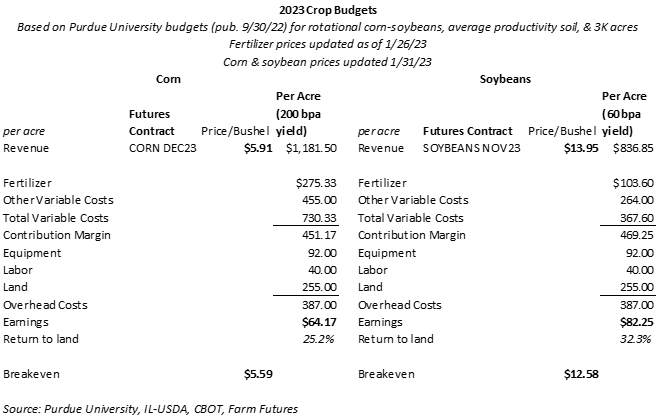
Acreage projections for the 2023 season are nonetheless one other two months from being finalized. However most growers have already determined 2023 acreage outlays. The January 2023 Farm Futures survey discovered that 70% of respondents had already locked in 2023 crop rotations as of late December 2022.
For the remaining 30% of our readers who’re nonetheless undecided at the beginning of 2023 about which acres supply probably the most profitable revenue choices, listed here are a couple of elements to look at within the coming weeks.
Value elements
As a price accountant in a earlier life, my bias leans closely in direction of the expense aspect of an earnings assertion when making operational selections. For these with comparable tendencies, crop budgets present an excellent launching level for deciding which acreage bundle will work greatest for the 2023 rising season.
Utilizing Purdue College’s figures for a 2023 corn-soybean rotation on common productiveness soil on a farm of three,000 acres and factoring in modifications in retail fertilizer prices since the newest numbers have been printed final fall, each corn and soybean acres look to be worthwhile choices in 2023 when utilizing late January 2023 futures costs.
On the finish of January 2023, retail prices in Illinois for most traditional NPK merchandise, aside from UAN, have been flat to 4%-23% decrease than the prior yr, representing the primary time within the final two years farmers have had the chance to make the most of value breaks for inputs.
Associated:Wheat enlargement to restrict corn, soybean acreage progress in 2023
The nitrogen conundrum
A hotter-than-average January might preserve a lid on vitality costs within the coming months, which might in flip assist average spring fertilizer costs. Preliminary world NPK utilization estimates for 2022 have been reported decrease, as farmers all over the world scaled again purposes in response to excessive costs and, in some circumstances (particularly Ukraine), availability points over the previous yr.
Within the U.S., a soggy spring 2022 planting season and excessive failed acres seemingly additionally decreased some purposes within the Northern Plains and Higher Midwest.
Whereas the extra world fertilizer stockpiling has despatched costs decrease for anhydrous ammonia and urea (in addition to phosphates and potash merchandise) over the previous a number of weeks, not all nitrogen merchandise are seeing value reductions. UAN costs stay over 5% increased (+$30.45/ton) than a yr in the past, which might deter farmers from corn acres this spring.
UAN continues to be a sizzling merchandise on the worldwide export market, particularly as European Union patrons search fertilizer merchandise for its upcoming rising season after the E.U.’s vitality trouble with Russia over pure fuel provides over the previous yr. Hovering pure fuel costs compelled many E.U. fertilizer producers to halt manufacturing final fall, which has left farmers dependent upon U.S. exports for essential provides.
Whereas some nitrogen costs are trending decrease, farmers shouldn’t count on 2023 to be as worthwhile as final yr. Purdue’s contribution margins calculate out decrease than 2022 due largely to the upper value atmosphere.
Despite the fact that my redneck math exhibits a revenue for each crops, there seemingly gained’t be as a lot wiggle room in 2023 margins as growers loved a yr in the past, notably if gross sales are usually not booked at present value ranges.
New period for value uncertainty
Per acre earnings for corn rotations in these Purdue/Farm Futures estimations shake out to round $64/acre. For soybeans, that determine is projected simply over $82/acre. Returns to land for corn are calculated at 25% and 32% for soybeans, making each choices viable revenue alternatives at harvest subsequent fall.
However once more – margins are being squeezed on either side this yr. On the income aspect of crop budgets, anticipated market common costs in Purdue’s budgets have been forecast 6% decrease for corn and eight% decrease for soybeans. Whereas these figures weren’t used on this evaluation, it does mirror market optimism for extra available provides within the new advertising yr.
Futures costs stay barely increased than these projections. However the monetary world stays on edge over a looming financial downturn that will inevitably take a chew out of commodity costs. Higher-than-expected rising climate in Brazil might additionally feed bearish value exercise within the U.S.
Wanting one other surprising climate downturn, don’t count on numerous assist from Uncle Sam for the 2023 season, both. ARC and PLC reference costs for corn and soybeans have been reported at $3.70/bushel and $8.40/bushel, respectively, for the 2023 rising season. That makes the probabilities for any help from both of those value insurance coverage packages slim, even when costs do shrink.
As any good accountant will inform you, these income and price projections can range throughout areas in addition to with totally different administration practices. Penciling out the numbers is a vital train for growers on the fence this yr, particularly as inputs and financing prices proceed to rise from final yr.



